ruger mkiii User Guide
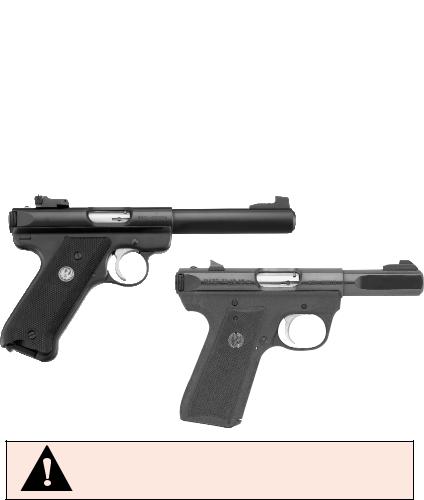
S
INSTRUCTION
MANUAL
FOR
BLUED & |
CALIBER |
STAINLESS |
.22 Long Rifle |
STEEL |
|
RUGER® MARK IIITM
AUTOLOADING PISTOLS
STANDARD, TARGET, GOVERNMENT TARGET, COMPETITION AND 22/45 MODELS
READ THE INSTRUCTIONS AND
WARNINGS IN THIS MANUAL CAREFULLY
BEFORE USING THIS FIREARM
For Product Service on This Model Please Call: (928) 778-6555 (See p. 30)
STURM, RUGER & Company, Inc.
Southport, Connecticut 06890 U.S.A.
THIS INSTRUCTION MANUAL SHOULD ALWAYS ACCOMPANY THIS FIREARM AND BE TRANSFERRED WITH IT UPON CHANGE OF OWNERSHIP, OR WHEN THE FIREARM IS LOANED OR PRESENTED TO ANOTHER PERSON
AP & KAP 5/04 C

State-By-State Warnings
Certain states require by law that their own specified warning notices in larger-than-normal type be conspicuously included by the manufacturer, distributor, or retail dealer with firearms sold in that state. Sturm, Ruger sells its products in compliance with applicable laws and regulations. Because our products may be sold in these states, we include the following:
California:
 WARNING
WARNING
“Children are attracted to and can operate firearms that can cause severe injuries or death. Prevent child access by always keeping guns locked away and unloaded when not in use. If you keep a loaded firearm where a child obtains and improperly uses it, you may be fined or sent to prison.”

 ADVERTENCIA
ADVERTENCIA
“A los niños los atraen las armas de fuego y las pueden hacer funcionar. Ellos pueden causarses lesions graves y la muerte. Evite que los niños tengan accesso a las armas de fuego guardándolas siempre con llave y descargadas cuando no las esté utilizando. Si usted tiene un arma de fuego cargada en un lugar en que un niño tiene acceso a ella y la usa indebidamente, le pueden dar una multa o enviarlo a la carcel.”
Connecticut:
“UNLAWFUL STORAGE OF A LOADED FIREARM MAY RESULT IN IMPRISONMENT OR FINE.”
Florida:
“IT IS UNLAWFUL, AND PUNISHABLE BY IMPRISONMENT AND FINE, FOR ANY ADULT TO STORE OR LEAVE A FIREARM IN ANY PLACE WITHIN THE REACH OR EASY ACCESS OF A MINOR UNDER 18 YEARS OF AGE OR TO KNOWINGLY SELL OR OTHERWISE TRANSFER OWNERSHIP OR POSSESSION OF A FIREARM TO A MINOR OR A PERSON OF UNSOUND MIND.”
2
Maine:
“ENDANGERING THE WELFARE OF A CHILD IS A CRIME. IF YOU LEAVE A FIREARM AND AMMUNITION WITHIN EASY ACCESS OF A CHILD, YOU MAY BE SUBJECT TO FINE, IMPRISONMENT OR BOTH. KEEP FIREARMS AND AMMUNITION SEPARATE. KEEP FIREARMS AND AMMUNITION LOCKED UP. USE TRIGGER LOCKS.”
Maryland:
“WARNING: Children can operate firearms which may cause death or serious injury. It is a crime to store or leave a loaded firearm in any location where an individual knew or should have known that an unsupervised minor would gain access to the firearm. Store your firearm responsibly!”
Massachusetts:
“WARNING FROM THE MASSACHUSETTS ATTORNEY GENERAL: This handgun is not equipped with a device that fully blocks use by unauthorized users. More than 200,000 firearms like this one are stolen from their owners every year in the United States. In addition, there are more than a thousand suicides each year by younger children and teenagers who get access to firearms. Hundreds more die from accidental discharge. It is likely that many more children sustain serious wounds, or inflict such wounds accidentally on others. In order to limit the chance of such misuse, it is imperative that you keep this weapon locked in a secure place and take other steps necessary to limit the possibility of theft or accident. Failure to take reasonable preventive steps may result in innocent lives being lost, and in some circumstances may result in your liability for these deaths.”
“IT IS UNLAWFUL TO STORE OR KEEP A FIREARM, RIFLE, SHOTGUN OR MACHINE GUN IN ANY PLACE UNLESS THAT WEAPON IS EQUIPPED WITH A TAMPER-RESISTANT SAFETY DEVICE OR IS STORED OR KEPT IN A SECURELY LOCKED CONTAINER.”
3
New Jersey:
“IT IS A CRIMINAL OFFENSE TO LEAVE A LOADED FIREARM WITHIN EASY ACCESS OF A MINOR.”
New York City:
“THE USE OF A LOCKING DEVICE OR SAFETY LOCK IS ONLY ONE ASPECT OF RESPONSIBLE FIREARMS STORAGE. FIREARMS SHOULD BE STORED UNLOADED AND LOCKED IN A LOCATION THAT IS BOTH SEPARATE FROM THEIR AMMUNITION AND INACCESSIBLE TO CHILDREN AND OTHER UNAUTHORIZED PERSONS.”
North Carolina:
“IT IS UNLAWFUL TO STORE OR LEAVE A FIREARM THAT CAN BE DISCHARGED IN A MANNER THAT A REASONABLE PERSON SHOULD KNOW IS ACCESSIBLE TO A MINOR.”
Texas:
“IT IS UNLAWFUL TO STORE, TRANSPORT, OR ABANDON AN UNSECURED FIREARM IN A PLACE WHERE CHILDREN ARE LIKELY TO BE AND CAN OBTAIN ACCESS TO THE FIREARM.”
Wisconsin:
“IF YOU LEAVE A LOADED FIREARM WITHIN THE REACH OR EASY ACCESS OF A CHILD YOU MAY BE FINED OR IMPRISONED OR BOTH IF THE CHILD IMPROPERLY DISCHARGES, POSSESSES, OR EXHIBITS THE FIREARM.”
* * * * * * * * * * * * * * * * * * * * * *
Please check with your licensed retailer or state police for additional warnings which may be required by local law or regulation. Such regulations change constantly, and local authorities are in the best position to advise you on such legal matters.
4
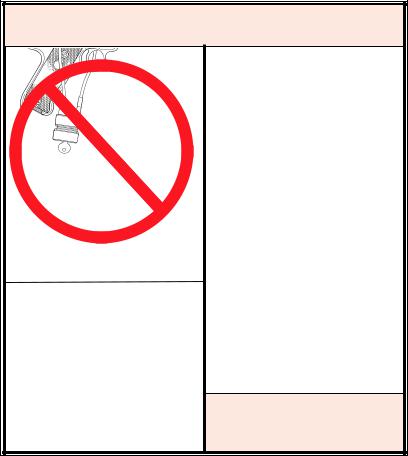
WHY ARE WE INCLUDING A FIRED CARTRIDGE CASE WITH EVERY RUGER PISTOL AND REVOLVER?
Certain states and jurisdictions now require that all newly manufactured pistols and revolvers must be accompanied by a cartridge case, which has been test fired from that gun at the factory. The case must be placed in a sealed container bearing certain information concerning this test cartridge.
At the time of retail sale in those jurisdictions, firearms dealers must forward such test cartridge to a designated destination such as their State Police Laboratory. As independent Ruger Distributors have nationwide markets without territorial restrictions, we have decided to include a fired cartridge case with all new Ruger pistols and revolvers, to minimize the possibility of inadvertent noncompliance with these laws.
Retail customers located in other states, where laws or regulations do not require the dealer to so act, may be assured that the fired cartridge case they receive with the firearm at the time of retail purchase is proof that your new Ruger firearm has undergone our normal test firing procedures during manufacture.
 WARNING —LOCKING DEVICES
WARNING —LOCKING DEVICES
DO NOT INSTALL
INSIDE TRIGGER GUARD
INSTALL LOCK
AS SHOWN HERE
This firearm was originally sold with a key-operated locking device. While it can help provide secure storage for your unloaded firearm, any locking device can fail. All guns are designed to fire
they are loaded and the trigger pulled. Therefore, never install
the locking device inside the trigger guard or in any way that
can possibly pull the trigger!
Do not leave the keys in the lock.
The ultimate responsibility for secure storage of any firearm must depend upon its owner and his or her individual circumstances. Guns should be securely stored unloaded, in a secure location, separate from their ammunition.
See “Warning-Storage,” page 28.
NEVER INSTALL
LOCKING DEVICE
INSIDE TRIGGER GUARD
5
FIREARMS SAFETY-YOUR RESPONSIBILITY
SAFETY MUST BE THE FIRST AND CONSTANT CONSIDERATION OF EVERY PERSON WHO HANDLES FIREARMS AND AMMUNITION.
This Instruction Manual is designed to assist you in learning how to use and care for your RUGER® MARK IIITM pistol properly. Please contact us if you have any questions about it.
Only when you are certain you fully understand the Manual and can properly carry out its instructions should you practice loading, unloading, etc. with live ammunition. If you have any doubts about your ability to handle or use a particular type of gun safely, you should seek supervised instruction. Such personalized instruction is often available from gun dealers, gun clubs or police departments. If none of these sources can help you, write to the National Rifle Association, 11250 Waples Mill Road, Fairfax, VA 22030-7400. They will assist you.
The person possessing a gun has a full-time job. You cannot guess; you cannot forget. You must know how to use your firearm safely. Do not use any firearm without having a complete understanding of its particular characteristics and safe use. Remember: There is no such thing as a foolproof gun.
TABLE OF CONTENTS
Page
General Information and Mechanical Characteristics . . . . . . . . . . . . . . . . . . . . 7 Operation of Manual Safety (Illustrations) . . . . . . . . . . . . . . . . . . . . . . . . . . . 10 Operation of Internal Lock . . . . . . . . . . . . . . . . . . . . . . . . . . . . . . . . . . . . . . . . .11 Ammunition . . . . . . . . . . . . . . . . . . . . . . . . . . . . . . . . . . . . . . . . . . . . . . . . . . . .12 To Load and Fire . . . . . . . . . . . . . . . . . . . . . . . . . . . . . . . . . . . . . . . . . . . . . . . . 13 Operation of Magazine Disconnect . . . . . . . . . . . . . . . . . . . . . . . . . . . . . . . . . .15 Operation of Loaded Chamber Indicator . . . . . . . . . . . . . . . . . . . . . . . . . . . . . .15 To Unload . . . . . . . . . . . . . . . . . . . . . . . . . . . . . . . . . . . . . . . . . . . . . . . . . . . . . . 16 To Extract and Eject a Chambered Cartridge . . . . . . . . . . . . . . . . . . . . . . . . . .18 To Clear a Malfunction (“Jam”) . . . . . . . . . . . . . . . . . . . . . . . . . . . . . . . . . . . . .19 To Minimize Malfunctions (“Jams”) . . . . . . . . . . . . . . . . . . . . . . . . . . . . . . . . .19 Basic Disassembly and Reassembly . . . . . . . . . . . . . . . . . . . . . . . . . . . . . .20 - 24 Magazine Disassembly . . . . . . . . . . . . . . . . . . . . . . . . . . . . . . . . . . . . . . . . . . . . 25 Care and Cleaning . . . . . . . . . . . . . . . . . . . . . . . . . . . . . . . . . . . . . . . . . . . . . . . 26 Storage . . . . . . . . . . . . . . . . . . . . . . . . . . . . . . . . . . . . . . . . . . . . . . . . . . . . . . . .27 Sight Adjustment . . . . . . . . . . . . . . . . . . . . . . . . . . . . . . . . . . . . . . . . . . . . . . .29 Attaching Ruger Scope Rings . . . . . . . . . . . . . . . . . . . . . . . . . . . . . . . . . . . . . . 29 Service and Parts Policy . . . . . . . . . . . . . . . . . . . . . . . . . . . . . . . . . . . . . . . . . . 30 Shipping Firearms For Repair . . . . . . . . . . . . . . . . . . . . . . . . . . . . . . . . . . . . . .30 Ordering Parts . . . . . . . . . . . . . . . . . . . . . . . . . . . . . . . . . . . . . . . . . . . . . . . . . .31 Parts List . . . . . . . . . . . . . . . . . . . . . . . . . . . . . . . . . . . . . . . . . . . . . . . . . . .32 - 35 Parts Drawings . . . . . . . . . . . . . . . . . . . . . . . . . . . . . . . . . . . . . . . . . . . . . . 36 - 38 The Basic Rules of Safe Firearms Handling . . . . . . . . . . . . . . . . . . . . . . . 39 - 42 Warranty Information . . . . . . . . . . . . . . . . . . . . . . . . . . . . . . . . . . . . . . . . . . . . 44
“RUGER®“ is a registered U.S. trademark. “22/45” and “Mark III” are Sturm, Ruger Trademarks.
6
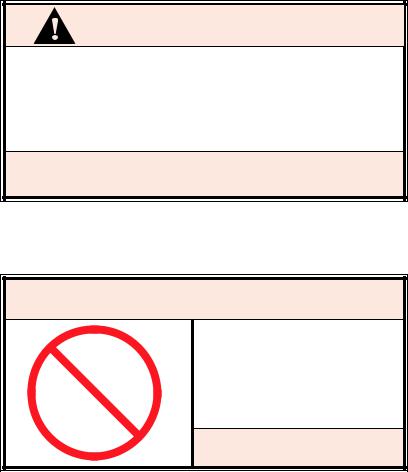
WARNINGS OF GREAT IMPORTANCE ARE
FOUND ON THE FOLLOWING PAGES:
Locking Devices |
5 |
Loaded Chamber Indicator |
16 |
Alterations |
7 |
Malfunctions |
19 |
Manual Safety |
10 |
Disassembly |
21 |
Ammunition |
12 |
Lubrication |
27 |
Lead Exposure |
12 |
Storage |
28 |
Firing |
14 |
Shipping |
30 |
Handling |
15 |
Parts Purchasers |
31 |
OTHER CAUTIONS AND WARNINGS APPEAR
THROUGHOUT THE MANUAL.
FIREARMS ARE DANGEROUS WEAPONS—
READ THE INSTRUCTIONS AND WARNINGS IN THIS MANUAL THOROUGHLY AND CAREFULLY BEFORE USING.
 WARNING—ALTERATIONS
WARNING—ALTERATIONS
This product was designed to function properly in its original condition. Alterations can make it unsafe. Do not alter any part or add or substitute parts or accessories not made by Sturm, Ruger & Co. Inc.
DO NOT ALTER ANY GUN
GENERAL INFORMATION
AND MECHANICAL CHARACTERISTICS
RUGER® MARK III pistols are differentiated from Ruger Mark I and Mark II pistols by certain external differences in markings and exterior components (magazine latch, bolt, ejection port, sights, and grip configuration) and by the presence of certain new features for which patents are pending such as internal locks, loaded chamber indicators, and magazine disconnects.
The RUGER® MARK III Standard model is a .22 caliber rimfire, 10-shot, magazine fed, autoloading (‘blowback’) operated pistol.
The RUGER® GOVERNMENT TARGET MODEL MARK III has a longer, heavyweight barrel and is laser targeted at the factory, just like pistols delivered to the U.S. Government for target shooting and training.
7
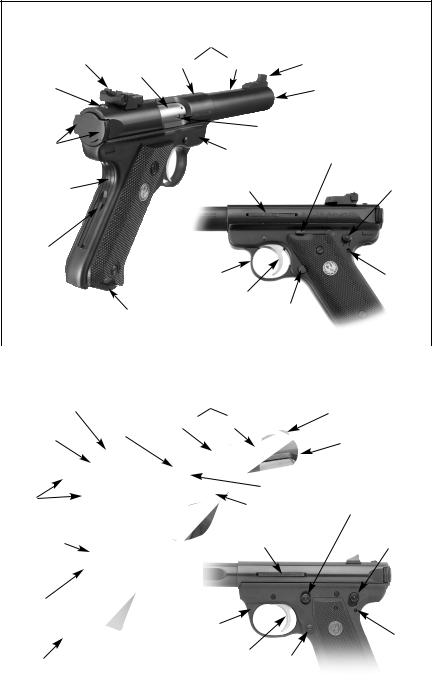
NOMENCLATURE
(All Mark III s other than 22/45 Mark III Models)
Barrel-Receiver
Assembly
Rear Sight |
Receiver |
Barrel |
Front Sight |
|
Bolt Stop Pin |
Bolt |
|
|
|
|
|
|
Muzzle |
|
|
|
|
|
|
|
|
|
Extractor |
|
Bolt Ears |
|
Grip Frame |
|
|
|
|
|
Bolt Stop |
|
Mainspring |
Loaded Chamber |
Safety |
||
|
Indicator |
(shown ON ) |
||
Housing |
|
|||
|
|
|
|
|
Mainspring |
|
|
|
|
Housing |
|
|
|
|
Latch |
|
|
|
|
|
Trigger |
|
Internal |
|
|
Guard |
|
|
Lock |
|
|
Trigger |
Keyway |
|
|
|
|
||
Grooved Foot |
|
Magazine |
|
|
|
Release |
|
||
of Magazine |
|
|
||
|
Button |
|
||
|
|
|
|
|
|
||||
|
|
|
|
|
(22/45 Mark III s (P4GC shown below)) |
||||
|
Barrel-Receiver |
|
|
|
Rear Sight |
Assembly |
Front Sight |
||
|
Receiver |
Barrel |
|
|
Bolt Stop Pin |
Bolt |
|
|
Muzzle |
|
|
|
||
|
|
|
Extractor |
|
Bolt Ears |
|
Grip Frame |
Bolt Stop |
|
Mainspring |
|
Loaded Chamber |
Safety |
|
Housing |
|
Indicator |
(shown ON ) |
|
Mainspring |
|
|
|
|
Housing |
|
|
|
|
Latch |
|
|
|
|
|
Trigger |
|
Internal |
|
|
Guard |
|
|
|
|
|
|
Lock |
|
|
|
|
|
|
|
Trigger |
|
Keyway |
|
Magazine |
Magazine |
|
||
|
|
|
||
Bottom |
|
|
Release |
|
|
|
|
Button |
|
|
|
|
|
|
8
The RUGER® COMPETITION MODEL MARK III has a slab-sided, heavyweight barrel with target grips and a scope base supplied with optical sight mounting rings.
The RUGER® 22/45 MARK III has a grip frame assembly made of molded synthetic polymer, with a grip shape and angle generally similar to “1911”-style
.45 caliber pistols.
All RUGER® MARK III pistols have the same basic operating mechanism and include the following features with which the gun user should be thoroughly familiar:
Bolt Stop: When the last shot has been fired and the magazine is empty, the bolt stop automatically holds the bolt open. When there is an empty magazine in the pistol and the bolt is retracted manually, the bolt stop will automatically hold the bolt open. If a loaded magazine is inserted in the pistol when the bolt is closed and the bolt is then retracted fully, the bolt stop will not automatically hold open the bolt. The user can actuate the bolt stop mechanism to hold the bolt open at any time by retracting the bolt and pushing up the bolt stop.
The bolt stop can be released when an empty magazine is in the pistol by drawing back slightly on the bolt and depressing the bolt stop thumbpiece. When the bolt is released, it will move forward under pressure from the recoil spring.
The bolt stop is spring-loaded or detented in position. Therefore, when there is a loaded magazine in place and the pistol is jarred, the bolt may fly forward and chamber a cartridge. For this reason and as an essential safety practice, the safety of the pistol should always be in the “on” (S) position except when the user is firing the gun at a selected target.
Magazines: The 10-shot magazine (Part M10MKIII) for the RUGER® MARK III pistol is different from all other Ruger rimfire pistols. In addition to the familiar removable plastic bottom decorated with a silver “eagle,” the M10MKIII magazine has a trigger interlock window and protrusion. (See “Magazine Nomenclature,” p. 25.) The M10MKIII is the only magazine that should be used in RUGER® MARK III pistols because it is designed to correctly function the bolt stop and magazine disconnect.
The RUGER® 22/45 MARK III pistol uses a different 10-shot magazine (Part AP10MKIII) which is identified by its removable elongated plastic bottom. The AP10MKIII magazine is distinguishable from earlier 22/45 magazines by the presence of the trigger interlock window and protrusion. (See “Magazine Nomenclature,” p. 25.) Note that the AP10MKIII is not interchangeable with the M10MKIII magazine described above. (See “Magazine Nomenclature,” p. 25.) The AP10MKIII is the only magazine that should be used in the RUGER® 22/45 MARK III pistols because it is designed to correctly function the bolt stop and magazine disconnect.
9
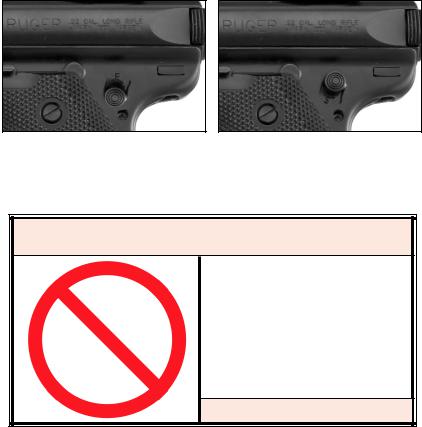
Safety: The safety locks the sear when the safety is “on.” Because the safety cannot be moved to its “on” (S) position unless the hammer is cocked, the safety therefore serves as a cocking indicator. The bolt can be manually retracted and released when the safety is “on” (S). This feature allows the pistol to be loaded or unloaded when the safety is “on” (S). As shown below and elsewhere in this Manual, the safety should be “on” (the “S” fully showing) at all times except when the gun user is deliberately positioned to fire at a selected target.
OPERATION OF MANUAL SAFETY
Figure 1. Safety in the “off” or “fire” (F) position. Safety is all the way down.
Figure 2. Safety in the “on” or “safe” (S) position. Safety is all the way up.
The Safety is not “on” unless it “clicks” fully up into the “S” position.
 WARNING —MANUAL SAFETY
WARNING —MANUAL SAFETY
Putting the safety between “S” and “F” can result in the pistol firing when the trigger is pulled. Always move the safety fully to its intended position and check it. The safety is not “on” unless it is completely “on.” Never depend on a safety mechanism or any other mechanical device to justify careless handling or permitting the pistol to point in an unsafe direction. The only “safe” pistol is one in which the bolt is open, the chamber is empty and there is no magazine in the gun.
NEVER PUT SAFETY 1/2 ON
10

OPERATION OF INTERNAL LOCK
Never rely upon any safety mechanism or mechanical device to justify unsafe or careless handling of a firearm. When securing your pistol or to prevent unauthorized access, you should completely unload the pistol and store it in a gun safe or use the key-operated external locking device supplied with your pistol. (See Page 5.) However, for added security, and to comply with certain state and local laws, your RUGER® MARK III pistol is also equipped with an internal lock. When actuated, this internal lock will secure the pistol’s manual safety in the "on" or "safe" position.
Before activating the internal lock on your pistol, first visually inspect the chamber and magazine to verify that they are empty and do not contain any cartridges.
To activate the internal lock, place the manual safety in the "on" or "safe" position. (Note that the pistol must be cocked to engage the safety.) Next, place the internal lock key (supplied with your pistol) into the internal lock keyway. (See “Nomenclature,” p. 8.) Rotate the key fully clockwise (about 1 3/4 of a rotation from the fully unlocked position) until it stops. (See Figure 3.) Remove the key and verify that the internal lock engaged by attempting to move the safety to the "off" or "fire" position. If the internal lock is engaged, you will not be able to move the safety to the "off" or "fire" position.
To deactivate the internal lock, place the internal lock key into the internal lock keyway (see “Nomenclature,” p. 8) and rotate the key counter-clockwise (about 1 3/4 turns from the fully locked position) until it stops. (See Figure 3.)
Be sure to store the internal lock key in a secure location, away from children and careless adults. Do not store your firearm with the key in the internal lock keyway. Never lock a loaded gun – always unload the gun before locking.
OPERATION OF INTERNAL LOCK
Place Manual
Safety “On”
Before Locking
Figure 3
11
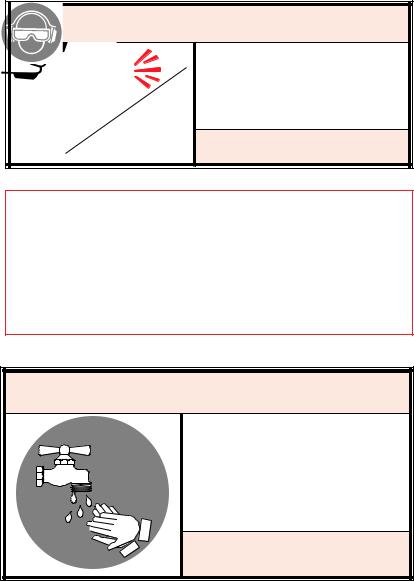
AMMUNITION
The RUGER® MARK III pistol is chambered only for the .22 caliber Long Rifle cartridge, standard velocity or high velocity, manufactured to U.S. Industry Standards. Do not attempt to load .22 Long, .22 Short, or any other type .22 caliber cartridge into the magazine or in the chamber of the pistol. Use of .22 shot shells is not recommended. See “Warning - Malfunctions,” p. 19.
 WARNING —AMMUNITION
WARNING —AMMUNITION
Death, serious injury, and damage can result from the use of wrong ammunition, bore obstructions, powder overloads, or incorrect cartridge components.
.22 cases are very thin and sometimes split when fired. Always wear shooting glasses and hearing protection.
IMPROPER AMMUNITION
DESTROYS GUNS
AMMUNITION (CARTRIDGES) NOTICE
WE SPECIFICALLY DISCLAIM RESPONSIBILITY FOR ANY DAMAGE OR INJURY WHATSOEVER OCCURRING IN CONNECTION WITH, OR AS THE RESULT OF, THE USE IN RUGER PISTOLS OF FAULTY, OR NONSTANDARD, OR “REMANUFACTURED” OR HANDLOADED (RELOADED) AMMUNITION, OR OF CARTRIDGES OTHER THAN THOSE FOR WHICH THE FIREARM WAS ORIGINALLY CHAMBERED.

 WARNING — LEAD EXPOSURE
WARNING — LEAD EXPOSURE
Discharging firearms in poorly ventilated areas, cleaning firearms, or handling ammunition may result in exposure to lead and other substances known to the state of California to cause birth defects, reproductive harm, and other serious physical injury. Have adequate ventilation at all times. Wash hands thoroughly after exposure.
SHOOTING OR CLEANING GUNS
MAY EXPOSE YOU TO LEAD
12
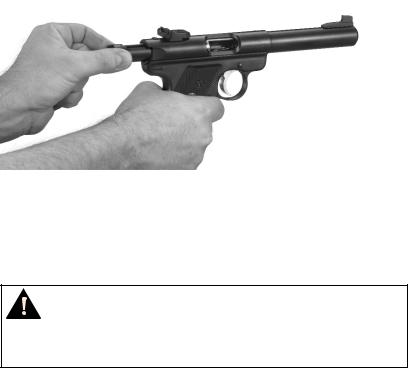
TO LOAD AND FIRE
Practice this important aspect of gun handing (with an unloaded pistol) until you can perform each of the steps — described below — with skill and confidence. But before you do anything with the pistol, first read completely through this manual.
1.Keep the muzzle pointed in a safe direction. (See Rule 2, p. 39.)
2.Push the magazine release button and pull the magazine down out of the grip frame by its foot.
3.Grasp the grooved ears of the bolt and pull the bolt to the rear as far as it will go. (See Figure 4, below.) This cocks the hammer and must be done before the safety can be put on.
Figure 4
4.Engage the safety by moving it fully upward so the “S” shows completely. (See Figure 2, p. 10.)
5.Put ten (10) or fewer .22 caliber Long Rifle cartridges into the magazine. In loading the magazine make sure that all of the cartridges lie parallel and evenly in the magazine. The follower button on the left side of the magazine is used to lower the follower so the cartridges can be readily inserted.
CAUTION: When using the follower button, have it under control. When loading or handling the magazine, do not pull the button down and then release it suddenly. The rim of the cartridge hitting the magazine lips may set off a sensitive primer and cause the cartridge case to discharge, burst violently, and result in injury.
6.Insert magazine into pistol, taking care that the magazine is fully inserted and locked in place. Slamming the magazine into the grip frame is not necessary.
7.Don’t touch the trigger. Pull the bolt to the rear as far as it will go. (See Figure 4, above.) Release the bolt so that it will fly forward. (On 22/45 models, the bolt stop must also be depressed to permit the bolt to fly forward.) This will place a cartridge into the firing chamber. If the pistol is not to be fired immediately, the safety button should remain “on” — with the “S” showing. (See Figure 2, p. 10.)
13
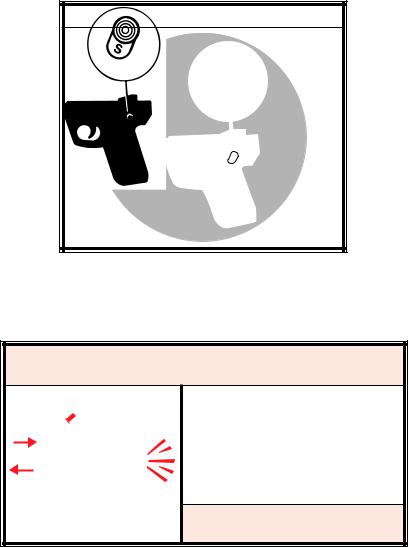
Once the safety is pushed down so the “F” shows, the pistol will fire a cartridge each time the trigger is pulled, until all of the cartridges in the magazine, and the one in the chamber, have been fired.
KEEP SAFETY ON
8.The pistol is ready for instant use once the safety is disengaged. Firing will automatically reload and recock the pistol. Note that every time the trigger is pulled, if a cartridge is in the chamber and the safety is “off,” the pistol will fire — be careful!
 WARNING —FIRING
WARNING —FIRING
The bolt automatically opens and shuts quickly while firing. Keep face and hands away from rear. Hot brass is ejected quickly and can burn you. Always wear shooting glasses and hearing protectors.
BOLT OPENS FAST -
HOT BRASS EJECTED
9.Immediately following the firing of a shot, and if a subsequent shot is not to be fired at once, put the safety in its “safe” position while the pistol is still pointing in a safe direction down range. Never put a loaded pistol down with the safety off!
14
